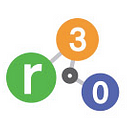What we’re reading at r3.0 (16)
By Ralph Thurm
At r3.0 we’re happy to see Said E. Dawlabani’s new book ‘Second Sapiens’ being published recently. We align on many things with Said, having gone from collapse awareness to collapse acknowledgement, to arrive at the need to focus on collapse resilience. We both agree on the need for systemic interventions in order to build what Said calls ‘Gaian Intellingence’. We would think that what we’re now up to at r3.0 could nicely be characterized as ‘in prolongation’ of what Said calls ‘Speaking Gaian Truth to Economic Power.’

As the book back cover text neatly puts it:
What will it take for us to preserve what remains of life on the planet? Is humanity itself at risk? These are the overarching questions Said Dawlabani asks in this book’s comprehensive development model. The current leading edge of intelligence that rules over our scientific, political, and economic reality is incapable of mitigating many of the unprecedented challenges we face.
Dawlabani asserts that our present institutions and ways of thinking are an extension of humanity’s journey through its first six stages of development that have been marked by imperfection ever since we became hunter-gathers. This is the journey of the First sapiens that has brought us to where we are now: to the edge of the Sixth Extinction.
Effective solutions to our problems need a whole ecosystem approach which is the domain of what Dawlabani calls Second Sapiens. It is an emerging expression of humanity that propels our psychosocial capacities into an exponential leap forward. It is on that other side where we embrace the complexities that have defined life for billions of years. Second sapiens answers the question: what would Mother Nature do? It is an alignment with that intelligence that takes into account all forms of life — not just our own — on this exquisite, fragile planet that happens to be the only one we have.
Said, who we know for more than a decade through direct interaction in our 20214 r3.0 International Conference in Berlin, Germany, where he held an opening keynote, has been a colleague and friend ever since. He asked our Managing Director, Ralph Thurm, to write one of the forewords in which he recommends a thorough read:

‘With the release of his book Memenomics (2013), Said Dawlabani entered my space in the search for the economic system design that supports all life in balance with Planet Earth. He brought the unique work of Clare Graves and of Don Beck’s Spiral Dynamics to introduce his distinctive developmental perspective on sustainability and regeneration. In 2014, he was the keynote speaker at the annual gathering of global sustainability experts organized by our nonprofit organization, r3.0 (Redesign, Resilience, and Regeneration).
In Second Sapiens, he takes his evolutionary framework one step further and offers additional insight into the needs of human enlightenment if we want to continue as a species. I specifically appreciate his clustering of the problems of the “Age of Acceleration” and the “Great Obsolescence” in part 1 of the book.
Unlike many who articulate these issues through a “meta-crisis” perspective, Dawlabani, through his stage-development life-cycle model, provides a deeper layer of connection that exposes the organizing principles underlying today’s chaos and collapse. But that is not the end of the journey, he says. He sees an awakening to a higher stage of human consciousness, a shift in humanity’s stages of development from that of the First to the Second sapiens.
Such profound change comes with his acknowledgement of collapse in part 2, specifically in chapter 7, “The Darkness before the New Dawn.” His conclusions and shift in focus parallels our own at r3.0 as we, too, have taken the steps necessary toward collapse resilience.
In part 3, Dawlabani looks at some of the leading-edge, economic-development models. His review includes sustainable development goals (SDGs), doughnut economics, planetary boundaries and alternatives to GDP measurement, not without hinting at shortcomings of their Second Sapiens potential, using criteria of the “Gaiametry economic protocols” to test their ultimate resilience.
I wholeheartedly agree with his summary in chapter 10: “A post-collapse homo sapiens will embrace higher states of awareness that reconnect us to the psychic and spiritual states that have long been sidelined. This is where the road to being one with Nature and cosmic wonder will begin anew. It is in these higher realms that natural and spiritual intelligence reside.”
Dawlabani’s new book is an appreciated and highly recommended contribution to the discussion about humanity’s future and role on Planet Earth.’
His two previous books, ‘Memenomics — The Next-Generation Economic System’ and ‘The Light of Ishtar — a Story of Love, Loss and the Search for Meaning’ are evenly advisable.
